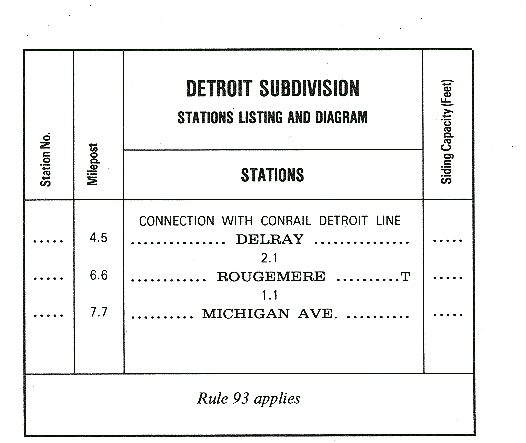
OPERATING INSTRUCTIONS
GOVERNING MOVEMENTS
ON DETROIT DIVISION
DETROIT SUBDIVISION BETWEEN
DELRAY TOWER MP 4.5 AND MP 7.7

Whenever and wherever rule numbers are indicated throughout this portion of the manual they are CSX rules.
All CSX rules quoted have been printed in the manual for your reference.
All movements are operated by signal indication.
Movements arriving and departing Rougemere Yard must be governed by instructions from the CSX Yardmasters.
Before trains are permitted to enter the Conrail territory the following information must be provided to -the Conrail Dispatcher:
-Initials and last name of conductor and engineman -Time on duty and time due to expire -Numbers of all units in consist -Loads, empties and tons -Information re Dangerous Commodities, dimensional loads, (including location in train) as well as speed restrictions if any.
DEFINITIONS
ABSOLUTE SIGNAL: A color light, color position light or semaphore signal without a number plate, "P" marker, "APP" marker, or "C" marker, that conveys Stop as its most restrictive indication.
CONTROL STATION: A space from which signals and signal appliances are operated or from which instructions governing railroad movements are issued.
SPEEDS:
CONTROLLED SPEED: A speed that will permit stopping within one-half the range of vision, short of a train, a car, an obstruction, on-track equipment or a stop signal.
RESTRICTED SPEED: A speed, not exceeding 15 miles per hour, that will permit stopping within one-half the range of vision, short of a train, a car, an obstruction, a stop signal, a derail or an improperly lined switch, looking out for broken rail.
-SLOW SPEED: A speed not exceeding 20 miles per hour.
SPEED RULES
40. Train speeds that are authorized by the rules, special instructions, signal indications, train orders or other means must be maintained to the extent feasible, consistent with safety, but must not be exceeded. When there is a difference in the speeds, the lowest speed wi II govern.
41. Unless otherwise specified, speed restrictions apply to the entire train. If a crew member is on the rear of the train, he must notify the engine crew, if feasible, when the rear of the train has passed through each speed restriction.
48. Trains using other than main or signalled tracks must move at a speed, not exceeding 25 miles per hour, that will permit stopping within one-half the range of vision, short of a train, a car, an obstruction, a derail or an improperly lined switch, on-track equipment or a stop signal. Trains moving on sidings may expect switches connected to the siding to be lined for movement on the siding.
(a) Unless equipped with a signal, 15 miles per hour through hand-operated turnouts and crossovers to and from the main track;
(b) 10 miles per hour through hand-operated turnouts and crossovers other than those to and from the main track; and
The following speeds must not be exceeded:
Maximum authorized speed........ 45 miles per hour
Delray interlocking limits...... 20 miles per hour